Biodiversity Hotspot in India: Hot spots are the areas where the density of biodiversity is very high. this high diversity is also known as megadiversity. These areas are the most threatened areas. Over the world, 25 terrestrial hot spots have been identified for the conservation of biodiversity. There are 4 hotspots of Biodiversity in India.
Out of 35 hotspots 15 hot spots are of tropical forests, 5 occur in Mediterranian-type zones and 9 hot spots are in tropics. All 35 hotspots together occupy 1.4 per cent total area of the earth’s land area.
Hot Spots also provide shelters for different types of living organisms. About 20 per cent of the human population also lives in all hot spots.
The great Ecologist Norman Myers developed the concept of ‘hot spots’ in 1988 to designate priority areas for in situ conservation. according to him ‘The hot spots are the richest and the most threatened reservoirs of plant and animal life on earth’.
How a Hot Spot Recognized?
There are so many areas which are very rich in biodiversity but we can not place those areas into a hotspot. there are parameters which decide whether an area is a hot spot or not. There are four ecological factors which determine a hot spot.
Hot Spots show a high degree of endemism. Hot Spots inhabited by a wide variety of these species.
| Flowering plants |
| Swallow-tailed butterflies |
| Amphibians |
| Reptiles |
| Mammals |
List of Biodiversity Hotspot in India
Here we are giving the list of Biodiversity Hotspot in India. There is a total of 35 hotspots all over the world. Out of these 35 hot spots, 5 are found in India. These are the following
(i) Hotspot in India: Western Ghats
The Western Ghats is biologically rich and biogeographically unique the Western Ghats is covering an area of 180,000 square kilometres. The Western Ghats covers 6% of the land area of Total Indian land,
The Western Ghats lies parallel to the Western Coast of the Indian peninsula. The Western Ghats occupy almost 1600 kilometre. It spread over in the following states of India
| SN | Indian State |
|---|---|
| 1. | Maharashtra |
| 2. | Karnataka |
| 3. | Tamil Nadu |
| 4. | Kerala |
It contains more than 30% of all Indian plants, fish, herpeto-fauna, bird, and mammal species. Many species are endemic in the Western Ghats, Such as Nilgiri tahr (Hemitragus hylocrius) and Lion-tailed macaque (Macaca silenus)
50% of India’s amphibians and 67% of fish species are endemic in the region of Western Ghats. Around 30% of the world’s Asian elephant (Elephas maximus ) and 17% of the world’s existing tigers (Panthera tigris) found in this area. their home.
The Western Ghats is the centres of biological diversity of:
- The Agastryamalai hills and Silent valley and
- The new Amambalam Reserve.
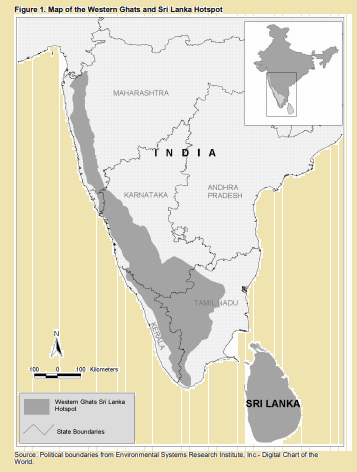
In the Western Ghats, the evergreen forests are found at low elevation. the elevation is approx 500 m above from sea level. Semi-evergreen forests occur at 500-1500m height in the western ghats.
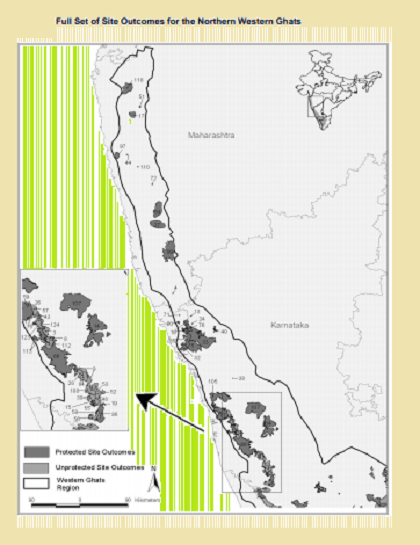
Iconic Species of Western Ghats
- The Great Indian Hornbill
- Gaur (Indian Bison)
- Lion Tailed Macaque
- Nilgiri Tahr
- Nilgiri Marten
Here is the list of Irreplaceable sites in the Western Ghats with Site Name, Special Species, Class with IUCN Status
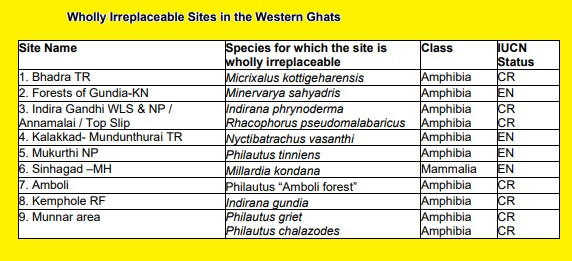
(ii) Hotspot in India: Eastern Himalaya
The Eastern Himalaya is situated in northeastern India and Bhutan. There are so many semi-isolated valleys in Eastern Himalaya. Eastern Himalaya is rich in endemic species of plants. These plants occur at an altitude of 1790- 3500m in temperate forests
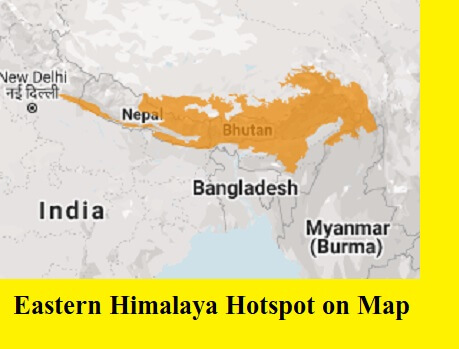
| SN | Flora and Fauna | Total Number of Species |
|---|---|---|
| 1. | Plants | 10,000 types of Plant |
| 2. | Mammals | 300 |
| 3. | Birds | 977 |
| 4. | Reptiles | 176 |
| 5. | Amphibians | 105 |
| 6. | Freshwater fish | 269 |
The Eastern Himalaya is an active centre of evolution. The eastern Himalaya exhibits a rich diversity of different types of flowering plants. Eastern Himalaya is also a centre of numerous primitive angiosperm families. These angiosperm families are Magnoliaceae and Winteraceae. Primitive genera of plants like Magnolia and Betula are found abundantly in this region of India
(iii) Hotspot in India: Indo-Burma Region
Indo-Burma hotspot spread in 2,373,000 square kilometres (916,000 sq mi) of tropical Asia and east of the Ganges-Brahmaputra lowlands. Formerly Indo-Burma hotspot has the area of the Himalaya chain and the associated foothills in Nepal, Bhutan and India,
Now Indo-Burma hotspot has been more narrowly redefined as the Indo-Chinese subregion. At present Indo-Burma hotspot begins in eastern Bangladesh and then extends to Myanmar. Now Indo-Burma hotspot also covers part of southern and western Yunnan Province in China, Lao People’s Democratic Republic, Cambodia and Vietnam, Thailand and Malaysia.
It also covers the coastal lowlands of southern China, as well as several offshore islands.
Iconic species of Indo-Burma Region
| SN | Class of Organisms | Species |
|---|---|---|
| 1. | MAMMALS | Pygmy loris (Nycticebus pygmaeus) |
| Delacour’s leaf monkey (Trachypithecus delacouri) | ||
| Saola (Pseudoryx nghetinhensis), | ||
| Lesser one-horned rhinoceros (Rhinoceros sondaicus) | ||
| Hairy rhinoceros (Dicerorhinus sumatrensis) | ||
| 2. | BIRDS | White-eyed river-martin (Eurychelidon sirintarae), |
| Giant ibis (Thaumatibis gigantea) | ||
| 3. | REPTILES | Cyrtodactylus gecko |
| Siamese crocodile (Crocodylus siamensis) | ||
| 4. | FRESHWATER FISHES | Mekong giant catfish (Pangasianodon gigas) |
| Mekong freshwater stingray (Dasyatis laosensis), | ||
| Giant carp (Catlocarpio siamensis) | ||
| Jullien’s golden carp (Probarbus jullieni). |
Read Also
- Biodiversity: Definition, Types, Magnitude, Gradients, Benefits, Threats, Conservation
- Wild Life Conservation: Definition, Types & Importance | HandwrittenNotes
- Senescence: Definition, Types Theories, Characteristics & Importance
- Parts of a Flowering Plant: The Root, Shoot, Leaf, Flower & Fruit
- Plant Water Relations: Imbibition, Diffusion, Osmosis, Absorption, Plasmolysis etc
- Living Organisms: Definition, Characteristics, Types and Examples
(iv) Hotspot in India: Sundaland
Sundaland is the most famous hot spot. This is one of the biologically richest hotspots on Earth at present. Sundaland includes several iconic species (i.e. orangutans and rhinos).

Sundaland id another valuable Biodiversity Hotspot in India. Sundaland covers the western part of the Indo-Malayan archipelago. This is the region in south-east Asia. Situated in Thailand, Malaysia, Singapore, Brunei and Indonesia and India. And also extends to the Nicobar Island which situated in India. In the year 2013, the United Nations declared islands a World Biosphere Reserve
Sundaland Island has a rich Terrestrial and Marine ecosystem. It has mangroves coral reefs and seagrass beds, in its terrestrial and marine ecosystem. the Marine biodiversity of Sundaland Island includes several species of whales, dolphins, dugong, turtles, fishes, lobsters, corals and seashells, crocodiles, prawns etc.
| SN | Biota | Description |
|---|---|---|
| 1. | PLANTS | Total species of vascular plants in Sundaland hotspot: 25,000 species Endemic plant genera: 117 (59 in Borneo, 17 in Sumatra, 41 on the Malay Peninsula) Notable plants Species: Members of the genus Rafflesia (16 species) |
| 2. | BIRDS | Total species of birds: approximately 770 Total endemic species: 150 Critically endangered species: Bali myna (Leucopsar rothschildi) |
| 3. | MAMMALS | Total species of mammals: Approx 380 – 450 Total Endemic species: 170 Notable species of mammals: Orangutans (2 Species: Critically Endangered species: Bornean orangutan (Pongo pygmaeus), Sumatran orangutan (P. abelii), proboscis monkey (Nasalis larvatus), Sumatran rhino (Dicerorhinos sumatrensis) |
| 4. | REPTILES | Total species of reptiles: More than 450 species Total Endemic species: Roughly 250 (Including 24 genera) Threatened reptiles: large river terrapins: mangrove terrapin (Batagur baska) and painted terrapin (Callagur borneoensis), Vulnerable species of tortoises and freshwater turtles. |
| 5. | AMPHIBIANS | Total species of amphibians: More than 240 species Total endemic species: Approx 200 |
| 6. | FRESHWATER FISHES | Total known species of freshwater of Sundaland: about 1,000 species Endangered species: Golden Arowana (Scleropages formosus) |
Iconic Species of Sundaland
| SN | Class of Organisms | Species |
|---|---|---|
| 1. | PLANTS | Rafflesia arnoldii, |
| BIRDS | Bali myna (Leucopsar rothschildi) | |
| Javan hawk-eagle (Nisaetus bartelsi), | ||
| 2. | MAMMALS | Bornean orangutan (Pongo pygmaeus) |
| Sumatran orangutan (P. abelii) | ||
| proboscis monkey (Nasalis larvatus), | ||
| Javan rhino (Rhinoceros sondaicus) | ||
| Sumatran rhino (Dicerorhinos sumatrensis), | ||
| 3. | REPTILES | Vulnerable false gharial (Tomistoma schlegelii), |
| Mangrove terrapin (Batagur baska) | ||
| Painted terrapin (Callagur borneoensis). | ||
| 4. | AMPHIBIANS | Slender toads (Leptophryne) |
| 5. | FRESHWATER FISHES | Golden arowana (Scleropages formosus) |
(v) Hotspot in India: Indian Ocean Islands
Madagascar and the Indian Ocean Islands hotspot is situated in the Indian Ocean. These are scattered islands in the Indian Ocean.
Madagascar is one of the most important parts of the earth with respect to biodiversity. Madagascar and Indian Ocean Islands Hotspot is notable for the extremely high floral and faunal endemism
The island of Madagascar is a part of Madagascar hotspot. Madagascar is a hotspot as well as Seychelles, Comoros, and Mauritius. Madagascar is approximately 400 kilometres off the Southeast coast of Africa.
Location of Madagascar on the map is 20°0′0″S, 47°0′0″E (degree, minutes, and seconds).
At 20°17′S, 57°33′E: Mauritius is found to the East of Madagascar. Seychelles lies in the ocean North of Madagascar. Seychelles is situated in between the coordinates of 4ºS and 10ºS and 46ºE and 54ºE.
At 12°10′S, 44°15′E: Comoros is located off the northwest coast of Madagascar
| SN | Biota | Description |
|---|---|---|
| 1. | PLANTS | Vascular Plants: Over 11,200 species are known |
| 2. | BIRDS | Approx 503 species are found 55 endemic species are Endangered |
| 3. | MAMMALS | 211 native species of land mammals |
| 4. | REPTILES | 457 species of reptiles |
| 5. | AMPHIBIANS | 309 identified |
| 6. | INVERTEBRATES | 5,800 species (and 2,500 pending description |
| 7. | FISHES | 108 species of sharks, including 11 that are endemic, and 66 species of skates. 2,086 species of fish that have to live in coral reefs |
| 8. | MARINE TURTLES | Endangered Species: green turtle (Chelonia mydas), hawksbill (Eretmochelys imbricata), olive ridley (Lepidochelys olivacea), loggerhead (Caretta caretta) and leatherback (Dermochelys coriacea) |
International Efforts for Conserving Biodiversity
In the year 1992, Earth summit of Rio de Janeiro, Brazil, promoted Convention of Biological Diversity (CBD). Earth summit of Rio de Janeiro, Brazil was signed by 152 nations. From 29’h Dec. 1993 recommendations of this summit came into effect. India became a part of this Convention in May 1994 which was basically based on Biological Diversity.
The convention ( Earth summit of Rio de Janeiro, Brazil ) has three key objectives
- Conservation of biological diversity
- Sustainable use of biodiversity
- Fair and equitable sharing of benefits arising out of the utilization of genetic resources
World Conservation Union and the World Wide Fund for Nature (WWF) are supported the number of projects for the conservation and appropriate development of Biosphere Reserves at the international level.
Hottest Hot Spots
Hottest hot spots are those hot spots which are having relatively more endemism and are more threatened. Among 35 hot spots of the world, 8 hot spots have been declared as the hottest hot spots.
List of Hottest Hot Spots
| SN | Name of Hottest Hot Spot | Place |
|---|---|---|
| 1. | Eastern and coastal forest of Tanzania /Kenya | Tanzania/Kenya |
| 2. | Western Ghat & Srilanka | India and Srilanka |
| 3. | Philippines | Philippines |
| 4. | Madagascar | India |
| 5 | Sunderland | India |
| 6 | Caribbean | North and South America |
| 7 | Brazil’s Atlantic | Brazil |
| 8 | Indo Burma | Vietnam, Thailand, Cambodia, Laos, Myanmar Eastern India and southern China |
India’s all hot spots come under the category of hottest hot spots because they are threatened.
The Megadiverse Countries
Conservation International identified 17 megadiverse countries in 1998. Many of them are located in, or partially in, tropical or subtropical regions.
There are so many countries that harbour the majority of the Earth’s species and high numbers of endemic species, these countries are a group of countries which are working to save biodiversity. These countries are known as megadiverse countries.
In 1998, Conservation International identified 17 megadiverse countries. Many of the megadiverse countries are located in, or partially in, tropical or subtropical regions
Brazil, China, Colombia, Costa Rica, India, Indonesia, Kenya, Mexico, Peru, the Philippines, South Africa and Venezuela, Mexican city declared to set up a Group of Like-Minded Megadiverse Countries. On 18 February 2002, the Ministers of these countries (in charge of the Environment) assembled in the Mexican city of Cancun to do this.
These countries work as a mechanism for consultation and cooperation to promote their interests and priorities, related to the preservation and sustainable use of biological diversity.
Similar Study Material
- Maths Handwritten Notes in Hindi Download PDF with Solutions
- Reasoning handwritten notes pdf download
- English grammar solved question papers with Solution (34 Set) Recommended for SSC Mains, IBPS
- Download General Hindi grammar objective questions pdf
- Download Environmental Science pdf in hindi, Environmental Science notes
Here we have Provided “Biodiversity Hotspot in India: The Western Ghats, Eastern Himalaya, Sundaland & Indo-Burma” we hope you like this article. if you have any query or suggestion, please leave a comment on the email. or contact us from contact us page.
Follow our official groups on Telegram, Whatsapp and Facebook

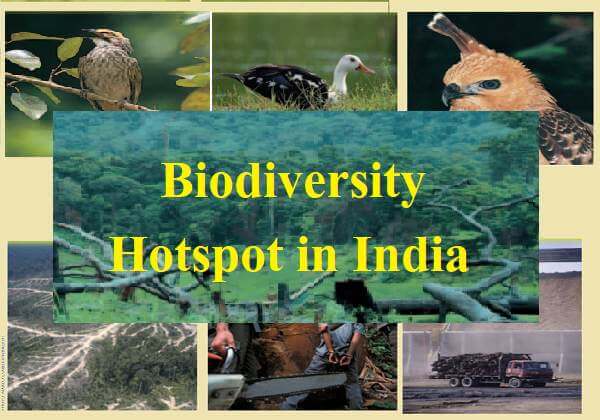
Good way of describing, and pleasant paragraph to take information concerning my presentation topic,
which i am going to deliver in academy.
I was suggested this website by my cousin. I’m not sure whether this post is written by him as
no one else know such detailed about my problem. You’re
wonderful! Thanks!
Thanks